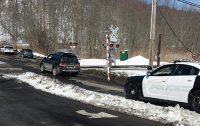New Castle to Pursue $50M Bridge Funding for Saw Mill Intersection

New Castle officials are pushing forward with efforts to pursue multiple sources of funding in hopes of eventually building a bridge over the Roaring Brook Road grade crossing and the Saw Mill River Parkway.
At a Nov. 15 work session discussion regarding potential improvements to the intersection, Jared Anderson, project manager at WSP Sells, which has served as a planning and engineering consultant to the town, and Director of Planning Sabrina Charney Hull agreed that now is the time for the town to make its pitch for the money to the federal government and various agencies.
Hull said in a recent meeting with the state Department of Transportation (DOT), there was acknowledgement that with the looming mixed-use build-out of the nearby Chappaqua Crossing in the upcoming years, anticipated delays from the MTA’s planned signal preemption at the grade crossing and already existing traffic generated by Horace Greeley High School and the parkway, a bridge is the most effective mitigation measure.
“I think we’re in a very strong position to make the case to why this should move forward if the town wants to move forward with it,” Hull said.
Anderson estimated that the project would cost as much as $50 million for a 440-foot-long bridge that is 75 feet wide and carries three lanes of traffic in each direction, including turn lanes. It would need to have about 22 ½ feet of clearance over the train tracks, he said.
The project’s costs could be reduced by as much as $20 million if the span was narrowed to four lanes but the town would risk seeing delays return if there was additional growth.
“If you put four lanes it might work okay when you build it, but then 10 years later you might have just wasted your money and you might have wished you had added those other two lanes for that extra few million,” Anderson said.
Twice in the past month, Anderson has addressed the town board regarding issues on how to improve the intersection’s operation for 2018, when the first elements of Chappaqua Crossing are expected to be in operation, and a scenario 10 years later in 2028.
Elongating turn lanes on the Saw Mill Parkway is one option that would likely keep the level of service status quo, he said. However, there are certain peak hours when the parkway operates at an F, a failing level.
Town Supervisor Robert Greenstein, who has strongly advocated for a bridge since the fatal grade crossing accident at Valhalla’s Commerce Street in February 2015, said a span would do more than reduce or eliminate congestion.
“We’re also eliminating two extremely dangerous conditions,” Greenstein said. “One is a grade crossing, two is a traffic light on a highway.”
In his experience, Greenstein said the government and its agencies prefer when there are numerous stakeholders involved and possibly contributing, even if that means there are multiple sources of small portions of money.
Hull said obtaining the funds is the most critical impediment to the project. While other projects that the town has looked would have only local impact, this would have regional impact, potentially attracting the attention of the federal government.
“This would solve a plethora of problems that are created by the MTA,” she said. “The MTA, the state, the Federal Railroad Administration, the federal government, we’ll be looking to everybody for the funding for it.”
Anderson said there are various sources of money that can be pursued. In fact, WSP Sells employs specialists whose job is to find public money and grants to build infrastructure projects, he said.
Traffic is expected to worsen in the near future not only with the eventual opening of Chappaqua Crossing, but the MTA’s planned signal preemption measures. Roaring Brook Road and two grade crossings in Valhalla are among the intersections in the Hudson Valley where the technology is scheduled to be installed.
Signal preemption would halt eastbound and westbound traffic along Roaring Brook Road for about 55 seconds each time a train passes through, Anderson said. The preemption system provides greater separation between the tracks and the cars to keep motorists as far away from the grade crossing as possible.
There is no taking of private land that would be necessary to build the bridge, Hull said. In the 1940s, Lila and DeWitt Wallace, the founders of Reader’s Digest, wanted a bridge built but the project cost too much, she said.
“At that time it was $250,000 to do a bridge. It was too expensive back then,” Hull said. “If we’re going to try and do it, we ought to try and do it now and do it big.”

Martin has more than 30 years experience covering local news in Westchester and Putnam counties, including a frequent focus on zoning and planning issues. He has been editor-in-chief of The Examiner since its inception in 2007. Read more from Martin’s editor-author bio here. Read Martin’s archived work here: https://www.theexaminernews.com/author/martin-wilbur2007/
